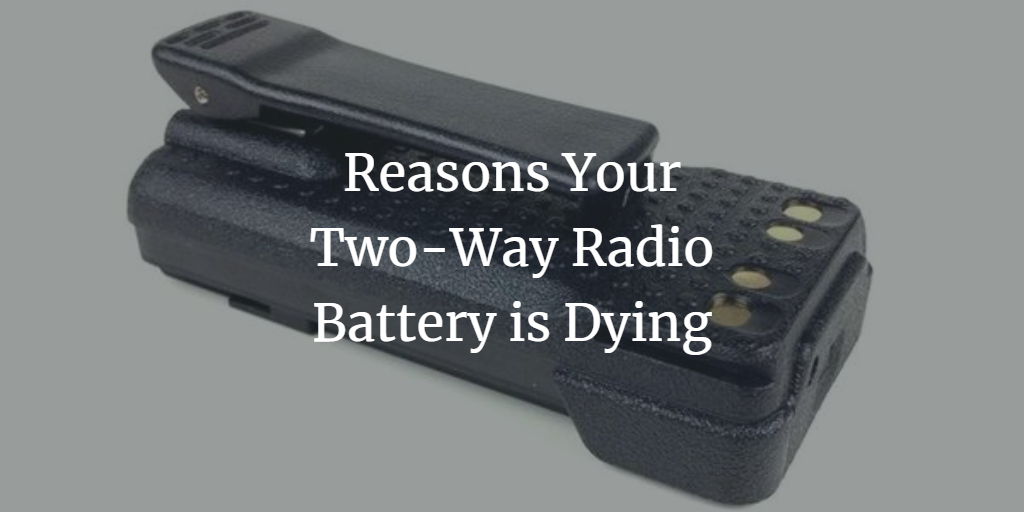For professions that use two-way radios as a communication tool, those radios are a lifeline. Two-way radios offer safety, prevention, and stability in any high-risk job. The batteries that are made to support portable radios are built to withstand factors like tough environments, long work times, and more.
Nevertheless, batteries still need to be maintained to a high standard to ensure they continue working properly. A two-way radio battery can start dying quickly for a few specific reasons. It is important every two-way radio user knows the signs of a dying battery to make sure they can fix the issue before the inevitable happens—the radio battery dying while on the job.
Below we list out three reasons why your two-way radio battery may be dying quicker than it should. We also give solutions to these problems, so if you are experiencing these problems with your battery, you can fix it as soon as possible.
Reasons why your two-way radio battery is dying quickly:
Problem—Age of the Battery:
Two-way radio batteries do not last a lifetime, especially when they are used daily. A problem like the age of the battery is not necessarily preventable but a user can pay attention to certain signs to know when it is time to switch the battery because of age. It is also important to be able to recognize the signs to differentiate between the battery and the radio causing any communication problems.
Signs that the portable radio battery is aging:
- The battery LED turns yellow or red
- If the battery is not charging as quickly as it used to
- Your radio’s communication range is shorter than is should be
Two-way radio batteries tend to have a lifetime of two years. Specifically, once a battery reaches the 18-month mark, the performance level will decline. Most, if not all, batteries are labeled with the year they were produced.
To check the year of a Motorola battery, find the four-digit code on the front of the battery. The first two digits represent the year. For example, the number 21 means year 2021.
Solution:
As stated previously, the aging of a battery cannot be prevented. Therefore, one of the best solutions is preparation. When purchasing your team’s batteries, check the dates. Mark down the date that is 18 months after the battery’s production year and plan to purchase new batteries on that date.
This way, if your team’s batteries begin to decline in performance in under two years, you will be prepared with fresh batteries.
Problem—Conditioning Issues:
Conditioning your battery is a crucial step to keeping up the battery life. When a battery is reconditioned, it undergoes several cycles to bring it back to a better capacity and reset its memory effect.
Batteries can “memorize” each charge cycle; if the battery is not fully depleted when placed on the charger, it remembers the cycle the next time and will not fully charge. Consequently, the battery will have a shorter operating time.
Therefore, if you are not conditioning your battery, this memory will take hold. Another problem that occurs, is some two-way radio users try to condition the batteries, but they do not do it properly.
Solution:
The solution is to start properly reconditioning your two-way radio battery. Reconditioning chargers are special charging platforms that automatically determine if the battery needs to be reconditioned; if it does, it will start the process immediately.
To manually recondition a battery, “within 2 1/12 minutes after placing your battery on a reconditioning charger, take the battery off the charger and immediately place it back on”. This method will start the reconditioning process—the charger should indicate a steady orange light.
However, do not manually recondition batteries often, this should only be done when necessary. Excessive reconditioning can dramatically reduce the operational time of your battery.
Problem—Lack of Proper Maintenance:
Conditioning your two-way radio battery does qualify as a form of battery maintenance; however, it is only one piece of the puzzle. Batteries are finicky and require care to sustain full performance ability for the whole lifetime.
Without proper charging, storing, and cleaning, the life of a battery significantly declines well before the two-year age mark. Therefore, it is important to maintain a two-way radio battery so users can avoid worrying about their battery having a working time of only 4 hours rather than the average 8 hours.
Solution:
When a two-way radio user begins taking care of their battery completely, it will be able to give the full performance ability for at least two years.
When storing batteries that are not in use, there are a few things to keep in mind. First, batteries should be left in a well-ventilated, cool, and dry place. These elements help prevent any parts of the battery from becoming damaged from things like humidity and dust.
Another tip for storing unused batteries is to make sure they are completely discharged before putting them away. Remember, batteries have a “memory,” if you store them at 50% charge, that is the charge it will remember, causing the battery to only have half the original working time.
In addition to proper storage, it is important to be mindful of the conditions where you are charging or just laying your batteries down when not in use. Surfaces that come in contact with two-way radio batteries should always be free from dirt and residues. Buildup of these elements on a battery are a main cause for improper charging of batteries and in turn improper battery life.
To clean a battery of dirt or residue, simply take a soft cloth and clean the affected areas. If a cleaner solution is needed to remove buildup, pure alcohol is recommended.
Lastly, if you are taking batteries out of storage, or batteries donated to your team, it is best to first run a discharge on all the batteries before recharging. Again, by doing this, it prevents any possibilities of the battery “remembering” a low charge.
...
Two-way radio batteries are a necessity in the public safety, construction, and manufacturing fields. These batteries are a cornerstone to modern critical communications. Consequently, batteries need to be properly cared for and understood to ensure longevity.
When teams pay attention to the age of their batteries, properly conditioning the batteries, and maintaining them, the batteries will be able to perform at the highest standards for two years or more. We hope this article armed you and your team with the necessary information to keep your batteries running smoothly.
Works Cited
“6 Common Two-Way Radio Problems and How to Fix Them.” Rock Networks, https://www.rocknetworks.com/6-common-two-way-radio-problems-and-how-to-fix-them-motorola-walkie-talkie-troubleshooting-guide/.
Karcich, Scott. “Have you checked your two-way radio battery lately?” Command Radio Communications, https://commandradio.com/have-you-checked-your-two-way-radio-battery-lately/.
Thomas, Taylor. “Why You Need to Recondition Two-Way Radio Batteries.” Waveband Communications, https://www.wvbandcoms.com/blogs/blog/reconditioning-batteries.
“10 Tips for Extending Your Two-Way Radio Battery.” Gencomm, https://gencomm.com/10-tips-for-extending-your-two-way-radio-battery/.
Wierzba, Mike. “Two-Way Radio Not Working? Check Your Battery Dates.” Chicomm Blog, https://www.chicomm.com/blog/two-way-radio-not-working-check-your-battery-dates.



